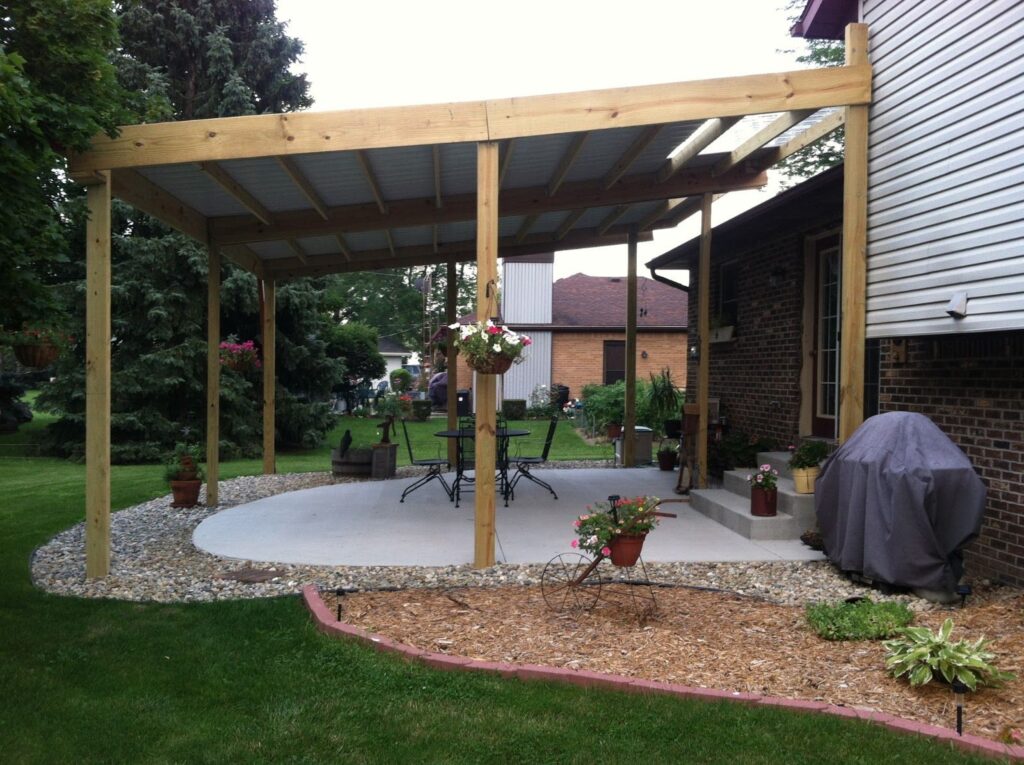What is a Patio?
A patio is an outdoor living space that is perfect for relaxation and entertainment. It is usually attached to the back of a house and can be made of different types of materials, such as wooden decks or concrete. A patio provides a unique opportunity to experience the beauty of nature while still enjoying the comforts of indoor living.
However, without any protection from the elements, a patio can be a truly uncomfortable place during inclement weather. This is where covering the patio comes in. Aside from protecting the outdoor space, there are several other benefits that come with covering a patio.
Benefits of Covering a Patio

If you’re looking to make the most of your outdoor living space, covering your patio can provide a host of benefits. Not only does it provide protection from weather elements, such as sun, rain or snow, but it also adds curb appeal to your home. A covered patio can be an attractive feature that adds value to your property and creates an inviting atmosphere.
In addition to enhancing your home’s aesthetic appeal, covering your patio can dramatically increase its functionality and create an extended living space. With a covered patio, you can enjoy your outdoor living space all year-round and in any type of weather. Rain, snow, or sunshine, your patio will be a welcoming space to relax, dine, or entertain friends and family.
One of the major advantages of a covered patio is its ability to provide a designated area for outdoor dining, hosting, and entertaining guests. You don’t have to worry about weather conditions – you can simply enjoy the great outdoors without any distractions. It offers a perfect blend of indoor and outdoor living, without leaving the comfort of your home.
Moreover, covering your patio can protect your outdoor furniture from aging, discoloration, and damage caused by exposure to harsh weather conditions. This extra layer of protection ensures that your precious furniture stays in tip-top shape and retains its appeal for a long time.
In conclusion, covering your patio is an excellent way to enhance your outdoor space, create a comfortable living area, and potentially add value to your property. With a covered patio, you can entertain guests, host dinner parties, or simply enjoy the outdoors without any worries.
Types of Patio Covers

There are many types of patio covers available to choose from, each with its own set of benefits and unique features. Shade sails are a versatile option that comes in various shapes and sizes, providing excellent UV protection and ample shade. Outdoor structures, such as gazebos and pergolas, add an element of elegance to your outdoor living space while offering protection from the sun and rain.
Permanent structures, like covered patios or solid roof structures, offer year-round protection and can be customized to suit your specific needs. If you’re looking for a more flexible option, retractable awnings can be easily opened or closed to control your exposure to sunlight. Patio umbrellas offer a quick and easy solution for up to moderate weather conditions but tend to be less durable compared to other covers.
Wooden pergolas create a rustic look and feel to any outdoor living space while providing adequate shade and a layer of protection from the elements. Galvanized steel is an industrial-looking option that’s perfect for contemporary or modern patio designs.
Finally, sail shades are sleek, stylish, and come in various configurations, making them an excellent choice for adding shade to larger areas. Each type of patio cover offers its own benefits, so it’s important to consider which option will work best for your home and outdoor living needs.
Shade Sails

Shade sails are a popular and cost-effective option for creating outdoor shade areas. They are made from sturdy, UV-resistant materials that are designed to block out the sun’s harmful rays and provide a shaded area for outdoor living. One of the main advantages of installing a shade sail is its ease of installation. Unlike other patio covers, shade sails are easy to set up and do not require a professional installation.
However, in order to ensure the stability and safety of your outdoor shade sail, it is important to have proper attachment points in place. This may include sturdy poles, walls, or other structures that are capable of supporting the weight of the sail and withstanding wind and other weather conditions.
When setting up a shade sail, there are several considerations that need to be taken into account. Size is an important factor, as the shade sail needs to be large enough to cover the desired area while still being able to secure it properly. Color and pattern may also be important factors to consider to ensure that the sail matches the surrounding outdoor décor.
Overall, outdoor shade sails are a cost-effective and easy-to-set-up option for creating shaded areas in your outdoor living space. By considering important factors such as proper attachment points, size, color, and pattern, you can successfully install a shade sail that will enhance your outdoor experience while providing the necessary sun protection.
Outdoor Structures
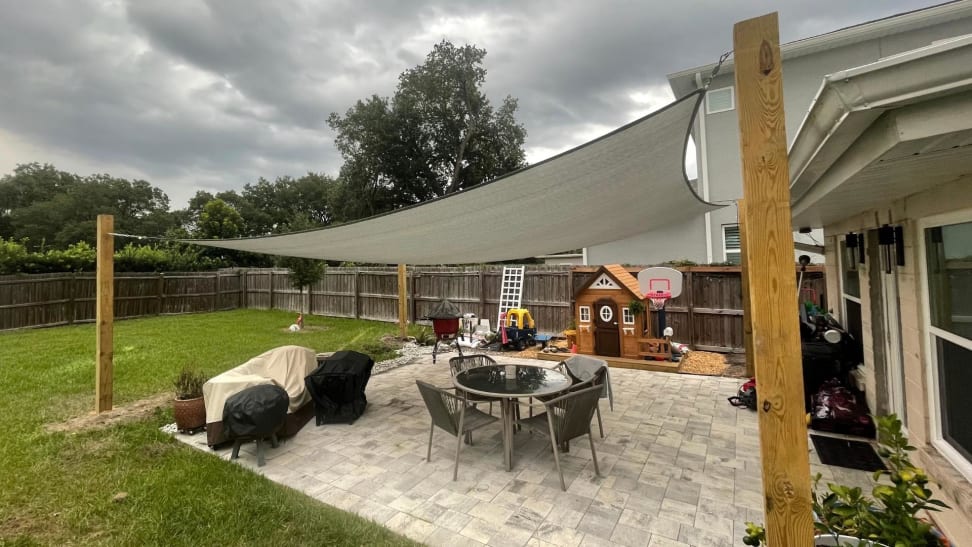
When it comes to covering a patio, there are a variety of outdoor structures that can be used to create shade and shelter. Each type of structure has its own benefits and drawbacks depending on your specific needs and preferences.
One popular option for patio covers is the wooden pergola. These structures typically consist of wooden beams or slats arranged in a grid pattern to create a partially shaded area underneath.
Wooden pergolas provide a natural, rustic look that blends well with outdoor scenery, and can be customized in terms of design and color. However, wooden pergolas require regular maintenance to prevent rot and decay, and may not provide enough protection from rain or wind.
Another option is galvanized steel structures, which offer a modern and long-lasting solution for patio covering. These structures are built with rust-resistant steel, which can withstand harsh weather conditions and require minimal maintenance.
Galvanized steel structures can be designed in a variety of styles and colors to match your overall outdoor aesthetics. However, they tend to be more expensive than other options and may require professional installation.
Sail shades are a unique and versatile option for those looking for a more flexible patio covering solution. These structures consist of triangular or rectangular pieces of fabric stretched between attachment points, creating a sleek, modern look. Sail shades are easy to install and are available in a range of sizes, colors, and patterns.
They also provide ample air circulation while protecting from the sun’s harmful UV rays. However, sail shades may not provide enough protection from rain or wind, and installation may require specialized hardware.
Less common options for patio covering include corrugated steel and solid roofs. Corrugated steel structures offer durability and longevity, with the added benefit of being lightweight and easy to install. They come in a range of colors and can provide a unique, industrial look to your outdoor space.
Solid roofs, on the other hand, provide complete protection from the elements, making them a great choice for those who want to use their patio space year-round. However, solid roofs tend to be more expensive and may require permits for installation.
In summary, there are a variety of outdoor structures available for covering your patio, each with their own advantages and disadvantages. Wooden pergolas provide a natural, rustic look, while galvanized steel structures offer modern and long-lasting solutions.
Sail shades provide flexible and stylish cover, while corrugated steel and solid roofs offer unique and complete protection from the elements. Consider your needs and preferences when choosing the perfect structure to create a comfortable and stylish outdoor living area.
Permanent Structures
Permanent structures can provide a sense of permanence and durability when covering your patio. Some popular choices for permanent structures include solid pillars, low walls, and solid roofs. These structures can be built up against the house to create a cohesive outdoor living space, giving your patio the feeling of an extension of your indoor living space.
Low walls can be a practical and stylish addition to any patio cover. They can be designed to be stepped over easily, making them a great option for those with small children or pets. Low walls can come in a variety of materials such as natural stone, brick, or wood.
The materials used for low walls can greatly affect the overall cost and lifespan of the structure. For example, natural stone may give a more high-end look but could be more expensive than wood.
Solid roofs provide an extra layer of protection against the sun and rain. They can come in a variety of materials such as wood, galvanized steel, or corrugated steel. The lifespan and cost of each material can vary greatly, with wood being a natural and warm choice but requiring regular maintenance to prevent rot and decay, while galvanized steel offers a modern and long-lasting solution but may cost more upfront.
To add to the aesthetic of the patio cover, consider adding outdoor furniture or rugs to make the space feel more complete. Outdoor furniture can be made from materials such as wicker, metal, or wood. Outdoor rugs come in a variety of materials such as synthetic or natural fibers, which can tie in the look of the patio cover with the rest of the outdoor space.
In conclusion, permanent structures such as solid pillars, low walls, and solid roofs offer a variety of materials and options to choose from when covering your patio. The design and material choices may impact the lifespan and cost of the structure but can greatly enhance the overall look and feel of your outdoor living space when paired with outdoor furniture and rugs.
Retractable Awnings
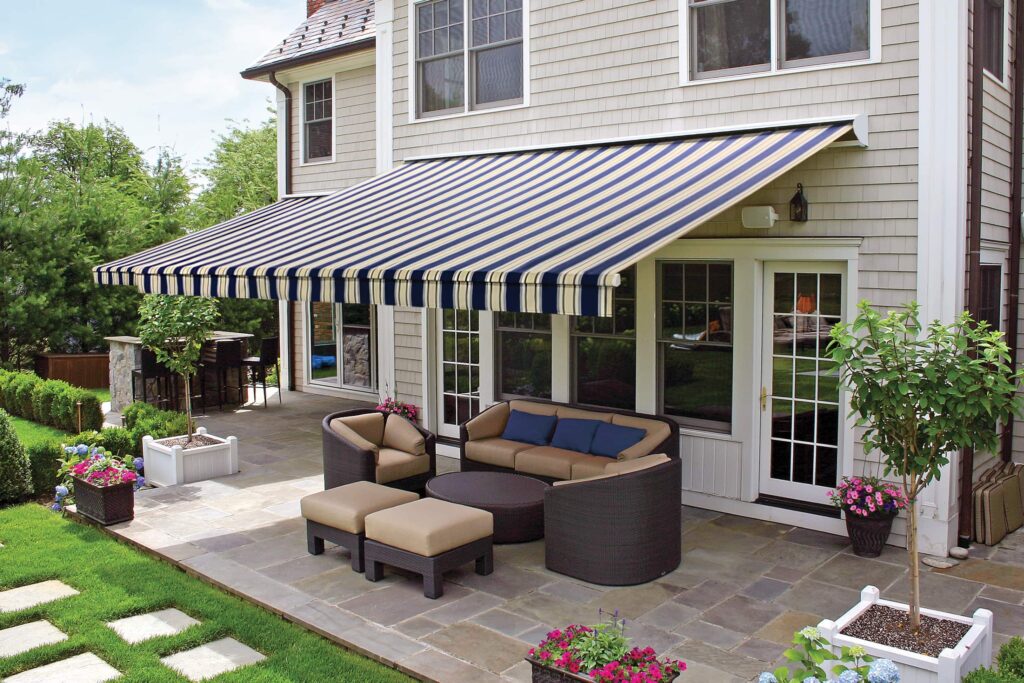
Retractable awnings are a versatile patio cover option that can provide shade and shelter when needed and retract to let in natural light when desired. This type of patio cover offers a range of benefits and drawbacks that every homeowner should consider before investing in one.
Benefits of Retractable Awnings
– Retractable awnings provide flexibility and can be adjusted to accommodate weather conditions and changes in natural light.
– They offer UV protection to prevent fading and damage to outdoor furniture and decor.
– They are easy to install and can be mounted to walls, soffits, or roofs.
– They come in a variety of sizes, colors, and designs to match different aesthetic preferences and patio styles.
– They do not require permanent structures or permits in most cases.
Drawbacks of Retractable Awnings
– Retractable awnings can be expensive, with some models costing hundreds or thousands of dollars.
– They may require maintenance and repairs over time, especially if they are subjected to heavy use or harsh weather.
– They may not be suitable for areas with high winds, and homeowners must take measures to prevent them from flipping or collapsing.
– They may not offer as much protection against rain and debris as solid patio covers.
Choosing and Installing a Retractable Awning
To choose and install a retractable awning, homeowners should consider the following factors:
– Cost range: Retractable awnings can range from $500 to $5,000 or more depending on the size, quality, and features. Homeowners should set a budget and research different models and brands to find the best value for their money.
– Local seller: Homeowners can find retractable awnings at home improvement stores, specialty shops, and online retailers. They can also contact local dealers and installers who offer customized options and professional installation services.
– Installation services: Homeowners can opt for DIY installation or hire a professional to ensure proper mounting and electrical wiring. Professional installers can also offer advice on placement, size, and maintenance.
– Materials: Retractable awnings can be made of different materials such as acrylic, polyester, vinyl, or aluminum. Each material offers different features such as waterproofing, durability, and aesthetic appeal. Homeowners should choose a material that suits their climate, aesthetic preferences, and budget.
– Manual and mechanical options: Retractable awnings can be operated manually with a hand crank or mechanically with a motor and remote control. Motorized options may be more convenient but also more expensive.
Considerations for Installing a Retractable Awning
Before installing a retractable awning, homeowners should consider the following:
– HOA regulations: Homeowners may need to obtain permits and follow certain guidelines to install a retractable awning in their neighborhood or community.
– Cutting procedures: Homeowners or installers should use proper cutting procedures to avoid damaging the fabric or frame of the retractable awning.
– Wind and weight limits: Homeowners should ensure that their retractable awning can withstand the weight of the fabric, the wind loads in their area, and the stress of frequent use. They should also take measures to secure the awning to prevent accidents or damage.
In conclusion, retractable awnings are a popular and convenient patio cover option that offer versatility, UV protection, and aesthetic appeal. Homeowners who want to invest in a retractable awning should carefully consider the benefits and drawbacks, choose the right size, material, and operating system, and follow proper installation and maintenance procedures to ensure their awning lasts for years to come.
Patio Umbrellas

Patio umbrellas are an excellent and affordable way to cover an outdoor space and provide protection from the sun, rain, or wind. There are many types of patio umbrellas available on the market, each with its own unique style, size, and material. In this article, we will discuss the various types of patio umbrellas, their sizes, and the materials used to make them.
The types of patio umbrellas differ in style, functionality, and design. The three most popular types of patio umbrellas are cantilever, market, and tilt umbrellas.
– Cantilever Umbrellas: Cantilever umbrellas feature a freestanding design with no center pole, creating more space for furniture and guests. The umbrella is supported by a side post and can pivot 360 degrees for maximum shade coverage.
– Market Umbrellas: Market umbrellas are the most common type that comes with a straight center pole. They are popular for restaurants and cafes and can enhance the ambiance of any outdoor space.
– Tilt Umbrellas: Tilt umbrellas have an adjustable stem, allowing you to tilt the canopy at various angles to block the sun efficiently. These umbrellas are ideal for places with constantly changing sun and wind directions.
Sizes of Patio Umbrellas
Patio umbrellas come in different sizes to accommodate various outdoor spaces. The sizes typically range from 6 feet to 11 feet in diameter. Smaller patio umbrellas are ideal for small patios, balconies, or intimate outdoor dining areas, while larger umbrellas are suitable for poolside areas and large gatherings.
Materials Used in Patio Umbrellas
Patio umbrellas are made with three primary materials: aluminum, wood, and fiberglass. Each material has unique benefits and trade-offs.
– Aluminum: Aluminum patio umbrellas are the most lightweight, durable and affordable options. They are resistant to rust and corrosion and easy to clean. However, they are not as aesthetically pleasing as wood or fiberglass and may not provide as much UV protection.
– Wood: Wooden patio umbrellas are more traditional and elegant-looking. They can blend well with rustic and natural environments and provide excellent UV protection. However, wooden umbrellas are more susceptible to water damage and may require more maintenance and repairs over time.
– Fiberglass: Fiberglass patio umbrellas are the most durable and wind-resistant option. They are lightweight, water-resistant and have excellent UV protection. However, they may not be as aesthetically pleasing as wood and are often the most expensive.
In conclusion, patio umbrellas are a great way to add shade and style to your outdoor space. Consider the size, style, and material when selecting the right patio umbrella that is both affordable and provides the right amount of shade and style to your outdoor space.
Wooden Pergolas
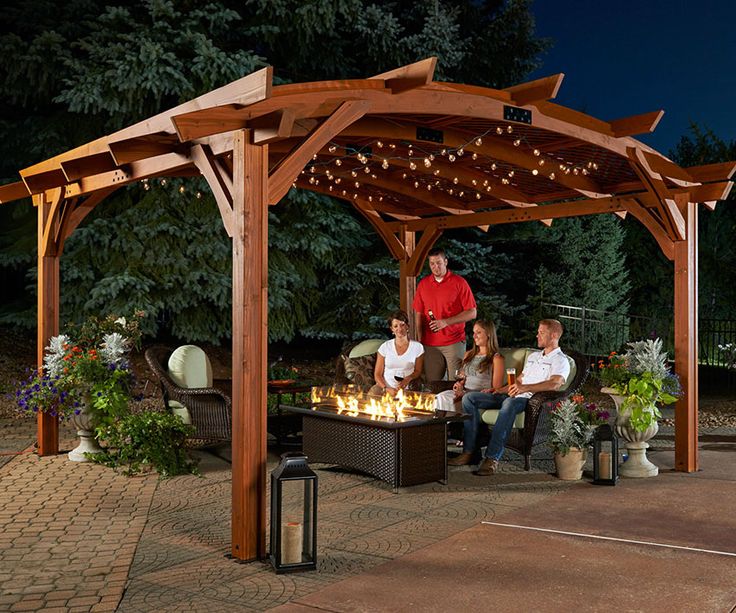
A wooden pergola is an excellent option for those seeking a charming and rustic way to cover their patio space. Not only does it provide shade, but it also adds a decorative touch to your outdoor living area, making it an ideal choice for avid outdoor enthusiasts.
One of the benefits of a wooden pergola is its durability and versatility. Wooden pergolas are sturdy structures that can withstand harsh weather conditions and can add value to your home. It’s a great option for homeowners looking to invest in their home’s outdoor appearance. Additionally, wooden pergolas can be customized to fit your individual needs and style preference.
The process of building a wooden pergola involves first measuring your patio and determining the height and size you want your pergola to be. Next, install post mounts in each corner and cut the corner posts to the desired height. Attach the corner posts to the mounts with wood screws and install cross-beams on top of the posts.
To ensure structural integrity, screw joist hangers into the cross-beams and nail the rafters into the joist hangers. Finally, install the roofing of your choice or leave the pergola open if you prefer to gaze up at the stars on a clear night.
In conclusion, a wooden pergola is a great investment for those seeking to add a rustic, decorative touch to their outdoor living space while also providing shade. Its building process is relatively simple and can be customized to fit your individual needs, making it an ideal choice for any homeowner looking to enhance their outdoor scene.
Galvanized Steel

Galvanized steel is a popular and cost-effective material choice for covering your patio. It is a type of steel that has been coated with zinc, which provides excellent strength and protection against rust and weather damage. Galvanized steel panels are a popular option for patios because they are durable, long-lasting and require little maintenance.
One of the most significant benefits of using galvanized steel is its durability. Galvanized steel panels are built to withstand harsh weather conditions, making them an ideal option for patios that are exposed to the elements.
Additionally, the zinc coating on galvanized steel makes it rust-resistant, ensuring long-term protection for your patio cover. Galvanized steel panels also have a sleek, modern appearance, making them a popular choice for those looking to enhance the aesthetic appeal of their outdoor living space.
When purchasing galvanized steel panels, there are factors to consider such as the size, thickness, and coating. The size of galvanized steel panels should be selected based on the area of your patio that you want to cover.
The thickness of the panels should also be chosen based on the level of durability that you require. The thickness will determine the panel’s weight, which will impact the required support structure. Finally, there are different types of coating options for galvanized steel, such as hot-dip galvanization, which provides additional protection against rust and weather damage.
The installation process for galvanized steel patio covers is relatively simple and can be completed with basic tools. First, the support structure must be established, which can consist of wood or metal beams that are screwed into the patio surface.
Once the support structure is in place, the galvanized steel panels are attached to the beams using bolts and screws. It is essential to ensure that the installation is carried out correctly to prevent shifting or instability over time.
In conclusion, galvanized steel is a durable, rust-resistant, and weather-resistant material that is an excellent choice for covering your patio. When purchasing galvanized steel panels, consider the size, thickness, and coating options. The installation process requires careful planning and attention to detail but can be completed with basic tools. Galvanized steel is an excellent investment for any homeowner looking to protect their patio and enhance their outdoor living space’s appearance.
Sail Shades

If you’re looking for an alternative way to cover your patio, sail shades could be an excellent option for you. Sail shades are a cost-effective and versatile alternative to traditional patio covers that can provide adequate shade while enhancing your outdoor space’s aesthetic appeal.
The design of sail shades can vary from triangular to square or rectangular and each shape offers particular benefits. Triangular sail shades are an excellent option for covering smaller areas, while rectangular sail shades are ideal for covering larger spaces. Square sail shades are versatile and can be used to cover anything from small patios to large outdoor dining areas. Regardless of the shape you choose, sail shades can be a stylish addition to any patio.
Sail shades are designed to withstand harsh weather conditions, making them an ideal choice for those who live in areas prone to high winds or heavy rainfall. They are made from durable, high-quality materials that are designed to resist fading, tearing, and rotting over time. Additionally, sail shades offer UV protection, which can be a crucial factor for those looking to spend extended periods outside.
One of the best things about sail shades is how easy they are to install. All you need is a set of poles and anchors, and you can have your sail shade up and ready to use in no time at all. Unlike traditional patio covers, sail shades can be adjusted to create the perfect amount of shade to suit your needs.
In conclusion, sail shades are a cost-effective and versatile option for covering your patio. They come in various shapes and sizes and are designed to withstand harsh weather conditions while providing adequate shade. The installation process is easy, making them an ideal choice for those who want a hassle-free option for their outdoor space. Consider sail shades for an effortless and stylish way to cover your patio.
Popular Choices for Patio Covers
If you’re looking for a classic and timeless option to cover your patio, a wooden patio cover might be the perfect choice for you. Wooden patio covers are known for their natural beauty and durability, and there are various options available to suit your individual style and needs.
On the other hand, string lights have become one of the most popular choices for outdoor lighting, and it’s no surprise why. These lights create a warm and cozy atmosphere that is perfect for enjoying your patio spaces at night. They are also an affordable and easy-to-install option, making them a popular choice for homeowners looking to enhance their outdoor living areas.
Wooden Patio Cover
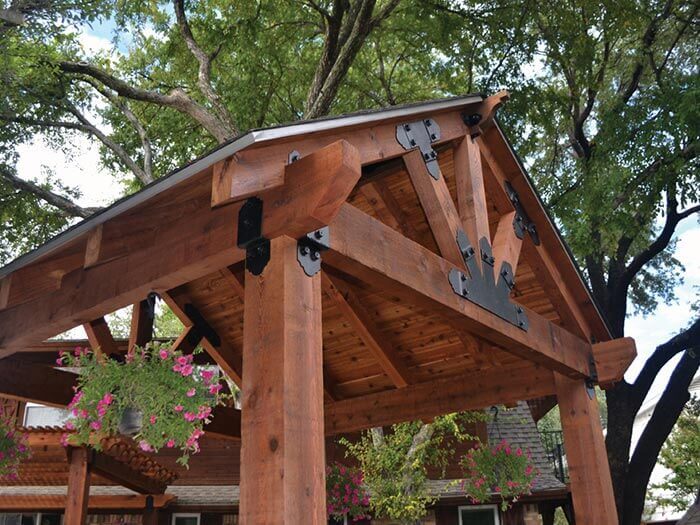
If you’re looking for a classic and timeless way to cover your patio, a wooden patio cover might be just what you need. With a little effort and some basic carpentry skills, you can build your own wooden patio cover that is both beautiful and functional.
The first step is to measure your patio and figure out what height your cover needs to be. Once you have the dimensions, you can choose the materials you need. Cedar is a popular option for building materials because it is weather-resistant and can withstand the elements. Additionally, it has a beautiful natural look that is perfect for an outdoor space. Alternatively, you could use any other type of weather-resistant lumber.
To build your wooden patio cover, you’ll need some basic tools such as a saw, hammer, drill, and screws. You’ll also need to create posts, cross-beams, and rafters, which will support the cover’s roof. Once you have these components assembled, you can then choose a type of roofing to complete your project. Popular options include shingle or corrugated plastic roofing, although you could use plywood as well.
One thing to consider when building your wooden patio cover is how it will be attached to your home or if it will be free-standing. If attaching to a home, you’ll need to make sure to properly anchor the cover to the side of the home. If making it free-standing, you’ll need to ensure that the structure has enough support to withstand wind and weather.
The beauty and versatility of wood make it an excellent choice for building a patio cover. It can be stained or painted to match the finish or roofing of your home, giving it a cohesive and finished look. The warm and natural feel of wood also adds to the ambiance and creates an inviting outdoor dining and living space.
A wooden patio cover is a great investment that can provide extra shade and protection from the elements, while also adding value to your home. With the right materials and tools, you can easily build your own wooden patio cover and enjoy your outdoor space all year round.
String Lights

String lights are a perfect, cheap, and easy way to spruce up your patio and create an inviting ambiance. The soft glow of these lights adds a touch of romance to your outdoor space and provides just the right amount of light.
Stringing up lights across your patio could not be easier. You can hang them from one side of the patio to another, string them along the perimeter, or even drape them in beautiful patterns overhead. The effect will be stunning, and your patio will look like a cozy hideaway.
This option is budget-friendly, requiring just a small investment in lights. Moreover, it is a quick and easy fix – you can enjoy your new look right away without spending a lot of money or time.
The best part about string lights is that they are versatile – they can be used for many different purposes. You could use them as light covers, strung up in a pattern, or drape them across your patio to create a colorful ceiling. You could even dress up a built-in patio with them.
In conclusion, if you’re looking for a budget-friendly way to make your patio look amazing, consider investing in some string lights. With a little time and effort, you can easily create a cozy outdoor space that you’ll love spending time in.
Considerations for Covering a Patio
When it comes to covering a patio, there are a few essential things to consider. First, you want to determine what type of cover you would like to install based on your preferences, budget, and maintenance requirements. There are several options available for patio covers, including shade sails, pergolas, and awnings.
Shade sails are a great choice for those who want a less permanent option that is easy to install and remove. They are typically made of a fabric that blocks out UV rays and provides shade from the sun. Pergolas, on the other hand, can be a more permanent option made of either wood or metal. They are often designed to provide support for climbing plants, creating a beautiful and natural addition to your patio.
Awnings are another great choice for those who want a more permanent solution. They are typically made of durable materials that can withstand the elements. Awnings are available in a variety of styles and can be customized to match the design of your patio.
Once you have decided on the type of patio cover, you will need to create a roof support structure. The structure can be made of wood, metal, or another suitable material. It is essential to ensure that your structure is strong enough to support the cover you have selected.
The materials you choose for your patio cover will depend on several factors, including your budget, the local climate, and your maintenance requirements. Popular choices include wood, metal, and fabric.
Wood is a great choice for those looking for a natural look, but it requires regular maintenance to prevent rot and decay. Metal is a more durable option, but it can be more expensive than wood. Fabric covers are available in a variety of colors and are a great choice for those looking for a colorful addition to their patio.
When designing your patio cover, it’s important to consider the orientation and size of your patio. This will help you determine the appropriate size and shape of your cover, ensuring that it provides the necessary shade and protection from the elements. You should also consider the intended use of your patio, as this may impact the type of cover you select.
In conclusion, covering your patio can be a great way to enhance your outdoor living space. When selecting a type of cover, consider your budget, maintenance requirements, and the materials needed. Ensure that your roof support structure is strong enough to support your chosen cover, and consider the orientation, size, and intended use of your patio when designing a cover that meets your needs.

